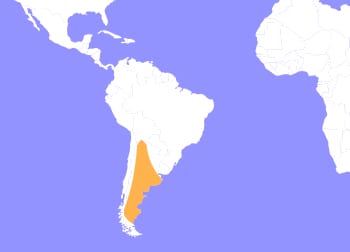Geoffroy's Cat
Leopardus geoffroyi
Geoffroy’s cat is a wild cat native to the southern regions of central South America. It is smaller than a domestic cat, and widespread and abundant over its range. The fur pattern of a Geoffroy’s cat has numerous black spots and dark bands covering its head, neck, and body. The primary color of its fur caries from brownish-yellow to a more grayish, depending on the region they come from. From the 1960s to the 1980s, Geoffroy’s cats were hunted extensively for their pelts used in the international fur trade. Legislation introduced in the late 1980s made hunting and domestic trade of their pelts illegal in parts of South America.
From head to tail, its length is about 3 feet, weighing between 4 to 10 lbs, though the largest recorded was 17 lbs. The Geoffroy’s cat occurs in Chile, Bolivia, Brazil, Argentina, Paraguay, and Uruguay. They inhabit pampas (fertile south american lowlands), savanna landscapes, and altitudes of 12,5000 ft in the Andes.
Geoffroy’s cats are nocturnal and are solitary hunters, only coming into contact with others during the mating season. It’s at the top of the food chain in its range and preys on rodents, hares, small lizards, insects, and occasionally frogs and fish. The range of Geoffroy's cat can be between 2.32 to 4.6 sq mi. The breeding season for Geoffroy’s cats lasts from October to March. Kittens are born blind and helpless, weighing 2 to 3.4 oz. They develop slower than a domestic cat would, with the eyes opening from eight to nineteen days.
Say Hello To Cub Creek's Geoffroy's Cat: Azizah
Azizah came to us in September of 2015 when she was about a year and a half old. She came with Pallida, one of our pale foxes, as bonded roommates. They grew up together in their previous home so we kept them in the same enclosure. Azizah looks and acts just like a kitten! She loves playing with cat toys just like your own cat might. You can find her (and Pallida) in the Fox Den during the summer. She loves shiny objects.

Geoffroy's Cats originate from South America, coming from parts of Chile, Bolivia, Brazil, Argentina, Paraguay and Uruguay.
HABITAT -They inhabit the lowlands, savanna landscapes, and parts of the Andes in South America.
DIET -They prey on rodents, hares, small lizards, insects, frogs, and fish.
FUN FACT -Geoffroy’s cats are strong swimmers that regularly enter the water!
SOCIAL BEHAVIOR -They live a solitary life in the wild, with males and females coming together during mating season.
ACTIVITY -They are active and hunt during the night, making them nocturnal.
PREDATORS -The only known predator is humans, hunting them for their fur.
SIZE -From head to tail, its length is about 3 feet, weighing between 4 to 10 lbs
RELATIVES -There are four subspecies of Geoffroy’s Cat, all located in South America.
CONSERVATION -The Geoffroy’s cat is considered Near Threatened on the IUCN Red List.
Cub Creek Animal Care Information
Housing - Our Geoffroy's cat is housed in a specialized enclosure with access to the outdoors and indoor portion to protect against weather. The outdoor portion of its enclosure has ramps made from wood, and branches high off the ground, giving it an environment that promotes play and exploration. On the inside, he has a climate controlled room bedded with shavings. You’ll also find a litter box, that’s right, our Geoffroy’s cat knows how to use a litter box.
Diet - We feed our Geoffroy’s Cat high quality cat food. This food provides well rounded nutrition, with multiple sources of protein containing buffalo, lamb, bison, chicken, venison, fish, and eggs. This dry food is supplemented with mixed vegetables, pinkies, insects, whole chicken, canned food, and fruit. These supplemented foods are fed to them in rotation.
Enrichment - Our Geoffroy’s cat likes to play just like their feline relatives. You’ll find her playing with ramps and clawing posts, that provides an environment that promotes playing and relaxation. She get plenty of socialization from humans, especially from our campers during the summer time. Campers will make toys for them out of feathers, cardboard, and plastic materials, they love to play with!

